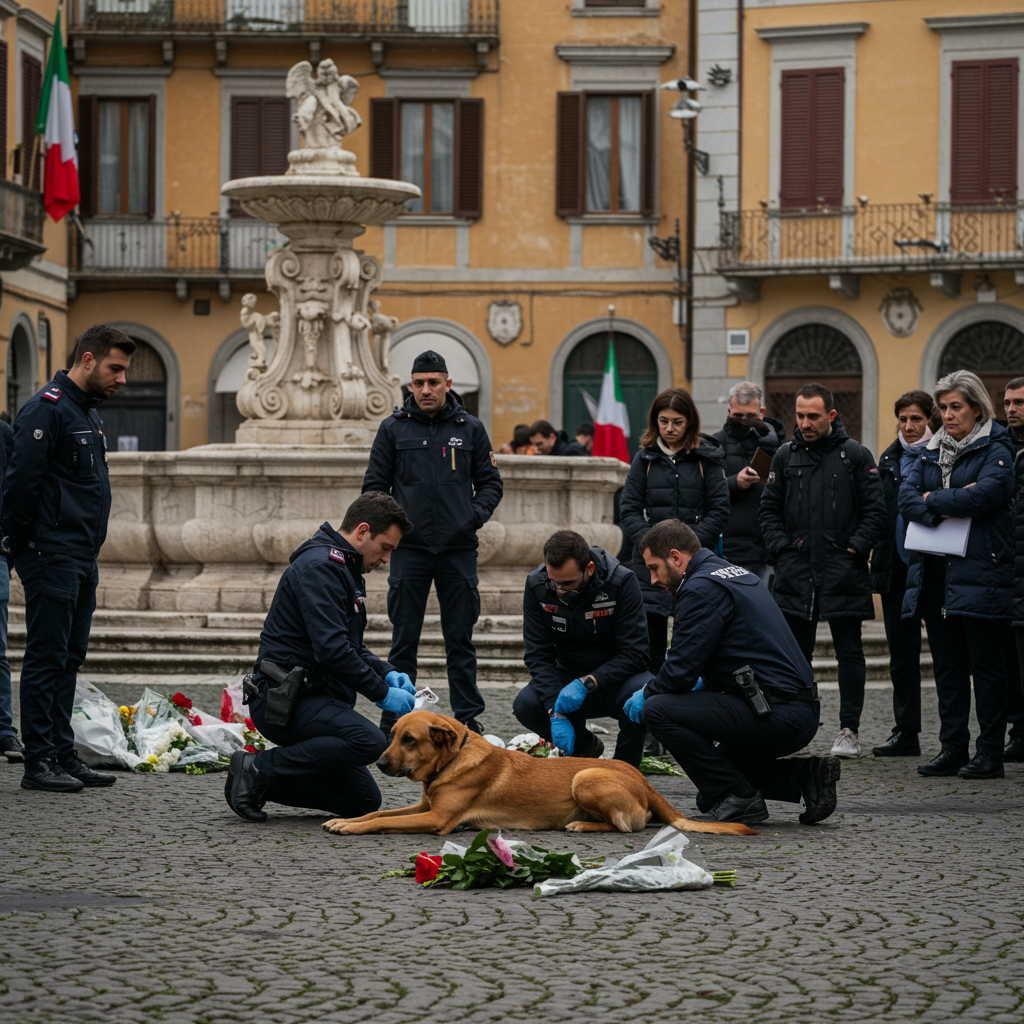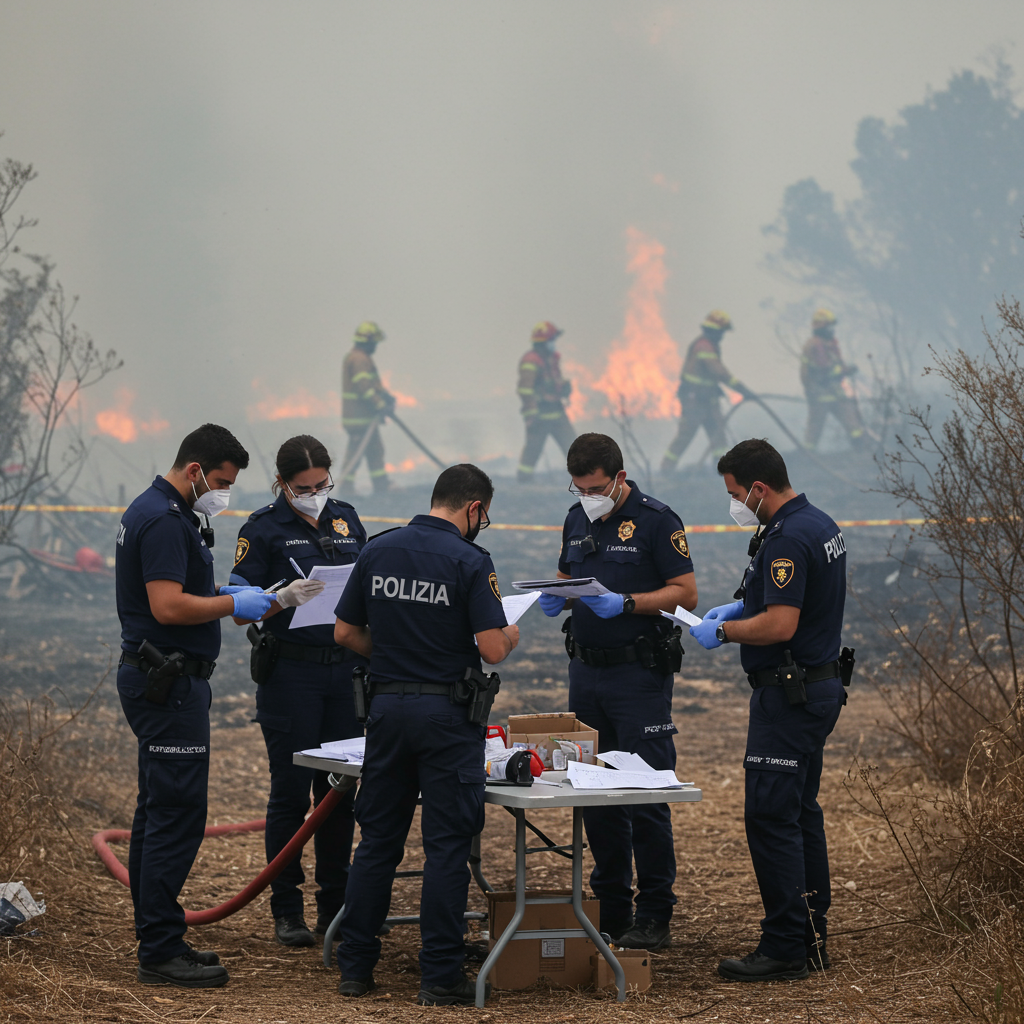The shocking, brutal killing of a dedicated police bloodhound in southern italy has ignited widespread fury across the nation and launched an intense criminal investigation. bruno, a seven-year-old canine veteran renowned for his life-saving search and rescue work, was discovered dead under horrific circumstances in Taranto. His death has become a symbol of outrage against animal cruelty and highlights the dangers faced by those combating illegal activities like dogfighting.
Bruno’s trainer, Arcangelo Caressa, found the powerful 88-kilogram (195-pound) bloodhound deceased in his shed one Friday morning. The grim discovery revealed the deliberate cruelty involved: Bruno had been fed dog food intentionally laced with nails. This horrific method was designed to inflict maximum pain and suffering, causing devastating internal injuries as the sharp objects tore through his esophagus and vital organs.
Heroic Service and a Tragic End
Bruno was far more than just a police dog; he was a hero with a remarkable service record. Over his career as a sniffer dog, he played a critical role in locating nine missing individuals. This included finding five people alive during desperate rescue operations, bringing hope and relief to their families. He also helped recover the bodies of four deceased individuals, providing closure for loved ones in tragic circumstances.
Caressa spoke movingly about Bruno’s dedication. Despite potentially appearing large or even clumsy to some, Bruno was exceptionally powerful and focused when working. “He was a giant,” Caressa recalled, describing how putting on Bruno’s harness transformed him. He would immediately pick up the scent and “run like a train” until he located the missing person. The commitment to finding everyone, alive or deceased, is a core principle for rescuers like Caressa: “Bring the missing person home in any case,” he stated, emphasizing that “there is always someone among their relatives who is looking for that missing person.”
National Outcry and Political Reaction
The savage nature of Bruno’s death prompted immediate and widespread condemnation throughout Italy. Public figures and ordinary citizens alike voiced their anger and grief over the loss of the heroic animal. Italian Premier Giorgia Meloni, who had previously met and been photographed with Bruno after one of his successful rescues, publicly denounced the act. She described Bruno’s slaughter as “vile, cowardly, unacceptable,” reflecting the depth of feeling across the country.
The reaction quickly moved beyond condemnation to calls for justice. Lawmaker Michael Vittoria Brambilla, a long-standing and prominent animal rights activist, took swift action. She filed a formal criminal complaint with prosecutors regarding Bruno’s killing. Her action leverages significant new legislation that she helped champion and which had only recently come into effect.
The New “Brambilla Law” and Stiffer Penalties
The criminal complaint filed by Brambilla is particularly significant because it falls under Italy’s new animal protection law, often referred to as the “Brambilla law.” This legislation was enacted on July 1, shortly before Bruno’s death, and represents a major step forward in strengthening legal protections for animals in Italy.
The new law dramatically stiffens the penalties for individuals found guilty of killing or mistreating animals. It stipulates potential prison sentences of up to four years for offenders. In addition to imprisonment, substantial fines can be imposed, reaching up to 60,000 euros (approximately $70,000). The law includes provisions for even harsher sentencing in cases where the mistreatment occurs in front of children or if the act is filmed and subsequently distributed online, underscoring a commitment to deterring and punishing the most egregious forms of animal cruelty.
Even with these increased penalties, some public figures felt the punishment for killing an animal as heroic as Bruno should be even more severe. Vittorio Feltri, the influential editor of the daily newspaper Il Giornale, was outspoken in his outrage. He argued that Bruno had contributed more civic good to Italy through his rescue work than many human citizens. Feltri suggested that the maximum four-year sentence under the new law might not be sufficient, emphasizing that animals deserve respect, especially when they demonstrate the kind of heroism Bruno displayed throughout his dedicated service career.
Motive: Revenge Against the Trainer?
As the criminal investigation into Bruno’s death began, the focus quickly turned to a potential motive. Trainer Arcangelo Caressa believes the attack was not random and was specifically directed at him rather than Bruno. He tragically concluded that Bruno was killed “to get to me,” suggesting the beloved bloodhound was murdered as an act of revenge targeting his owner and handler.
Caressa openly shared his suspicions with investigators and prosecutors. He leads ENDAS, a volunteer public animal rescue organization in Taranto. Part of ENDAS’s crucial work involves the dangerous task of rescuing dogs that are victims of illegal dogfighting rings. This type of rescue service was previously handled by private, for-profit firms. Caressa suspects that individuals connected to these former service providers, or perhaps involved in the illegal activities his organization disrupts, are behind the brutal killing.
Threats and Suspicions
Caressa revealed that his organization has experienced a period of escalating harassment and threats in recent months. He detailed receiving “threats, acts of persecution, defamation and slander” from certain individuals. He stated that these individuals are known to judicial authorities and have a history of being investigated. According to Caressa, these parties have been attempting to take over the rescue service using “despicable means.” He strongly suspects that Bruno’s killing is the most extreme manifestation of this campaign against him and ENDAS, a vicious attempt to intimidate or retaliate. He has reportedly provided investigators with the names of two individuals he suspects may be responsible for the crime, giving the investigation concrete leads to pursue.
The killing of Bruno has underscored the risks faced by those working on the front lines against animal cruelty and illegal animal trades in Italy. His tragic death has not only caused immense personal grief for his trainer and colleagues but has also galvanized public support for stronger enforcement of animal protection laws and a deeper appreciation for the vital role working dogs play in society. The investigation continues as authorities work to bring those responsible for this vile act to justice.
Frequently Asked Questions
What happened to Bruno, the police bloodhound in Italy?
Bruno, a 7-year-old police bloodhound known for his rescue work, was found dead in his shed in Taranto, southern Italy. According to his trainer, Arcangelo Caressa, he was deliberately fed dog food laced with nails, which caused severe internal injuries and led to his death. The killing was a horrific act designed to inflict extreme suffering.
Where did the killing of police dog Bruno take place?
The tragic incident involving the police bloodhound Bruno occurred in Taranto, a city located in southern Italy. Bruno was found dead in his shed there. His trainer, Arcangelo Caressa, discovered the body and reported the details of how the dog was killed.
What penalties apply under Italy’s new law regarding Bruno’s killing?
Bruno’s death falls under Italy’s new animal protection law, sometimes called the “Brambilla law,” which recently took effect. This law significantly increases penalties for killing or mistreating animals, allowing for potential prison sentences of up to four years and fines up to 60,000 euros. Stiffer penalties can apply if the act involves children or online dissemination.
The investigation into Bruno’s brutal killing remains active, driven by national outrage and the pursuit of justice under Italy’s strengthened animal protection laws. His legacy as a heroic rescuer continues to resonate, highlighting both the invaluable contribution of working dogs and the ongoing fight against animal cruelty.




